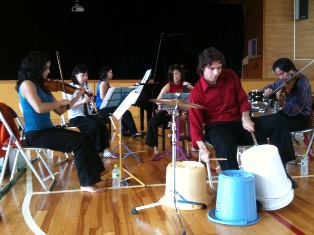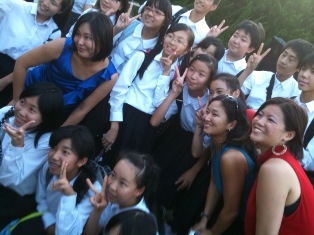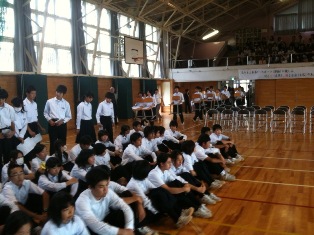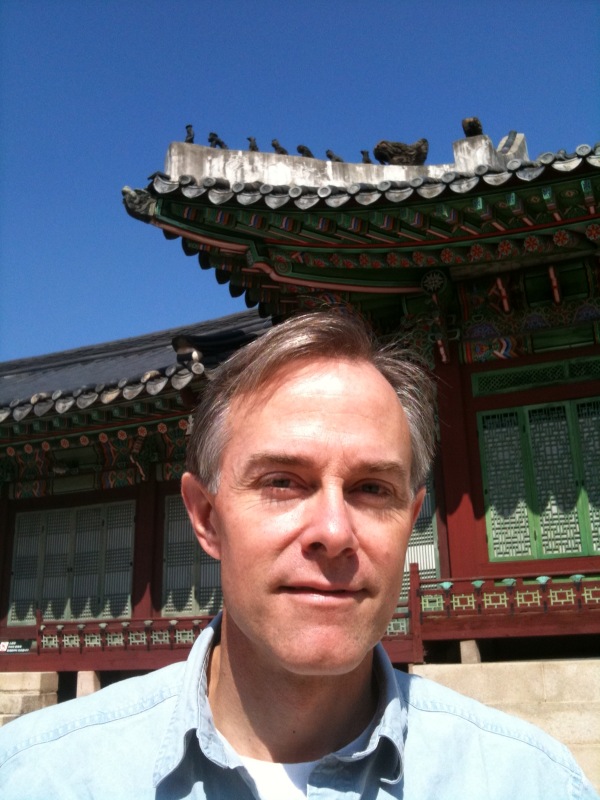To read Ted’s first blog; click this link.
Within the Western educational system, the Teaching Artist attempts the most complete realization of student-centered learning. To borrow from Eric Booth, the word “education” has the Latin root “ducare” – to lead or draw, with the prefix “e-“, out. The fundamental stance of the Teaching Artist is that every learner has inherent capacities that can be brought out by encounters with art. The encounter evokes a desire to know more, experience more, create more, that ignites learning.
If this is a difficult ideal to project in the United States, where high-stakes testing usurps more and more of the school day and teachers’ attention, imagine trying to communicate the concept of “e-ducare” to exam-centric Asian systems. For over a millennium, students’ futures in China, Japan, and Korea have hinged on their performance on state exams. The exam system reinforces a cultural reverence for the elder, the teacher, who provides all the knowledge a student needs to progress through the exams and on to a career. When Western classical music, with its emphasis on precise performance of detailed tasks, came to the Far East, it flourished in the exam system. Japanese and Korean musicians have already been renowned for several generations. Now China is training literally millions of violinists to very high standards. Many of the most recent hires at the New York Philharmonic – including the crucial principal oboe – have been born and trained in China. Why should Asian conservatories begin now to develop musicians’ engagement skills?
Teaching Artists of the New York Philharmonic have just completed a week of projects in three locations in Japan. Although this is the fourth year of such work, we continue to be struck by how different responses can be from those we encounter in New York – and how much the same. In Niigata, as I described in the last post, we found a university education faculty looking for new ways to tap children’s creativity as a learning tool. Students, in uniforms, were highly ordered as the marched into the gym for our interactive concert – which could be a good or a bad sign for engagement. But they came alive in response to the Teaching Artists’ enthusiasm and scaffolded presentation of ideas and activities (Junior high students, as in the US, though showing signs of engagement, were reluctant unto death about raising their hands, in contrast to their younger counterparts.) In the Minato ward of Tokyo, we returned to a progressive school called Nanzan Elementary. Here the students were too unfocused to participate fully, and teachers did little to restrain their chatter. The ensemble was playing music by six students at Nanzan – can you imagine how American students would capitalize on the opportunity for attention? Here, we were asked not to announce their names, and even so, the composers cringed, shrank from sight. (Come to think of it, I have had performances, as a composer, that made me feel that way – but I’m sure the performance level was not the issue here!) Nanzan seems to take an almost Western concern for students’ feelings, enabling them to opt out of important experiences. Uniform, Japanese education is not.
In Komae, an outlying ward of Tokyo, we presented a highly successful family concert. Children of all ages were much more apt to participate – to sing along when requested, to learn and clap rhythms, to volunteer ideas for composing on the spot, to take a shot at drumming on compound buckets – when with their families, than with their classes. The lesson again: once you let kids know it is OK, indeed encouraged, for them to volunteer thoughts, to try things they haven’t yet mastered, they can dive in and have fun pretty much like their Western counterparts.
Arts administrators who attended a seminar we gave on Teaching Artistry yesterday took copious notes and nodded vigorously (a confusing tendency among Japanese, not by any means indicating consent). Those who spoke with me afterward were thrilled by the possibility of making deeper connections with their communities, which seems increasingly to be their mandate. Whether arts presenters will develop an infrastructure for Teaching Artists remains to be seen.
The response of professional musicians, as reported by our partner and host, Kazumichi Sunada of Life With Music Project, tends to be depressingly similar to that in the US: musicians who need to play for kids must not be good enough to play for adults. Any who heard the Teaching Artists Ensemble perform would have been surprised – I know I have never heard a better Brahms Piano Quartet in g minor, and these musicians can improvise, too. Meanwhile, Riichi Uemura and Mizuka Motoki, who joined the ensemble as apprentices, describe a life-altering shift of perspective. Riichi had already given up a life as a professional quartet player in Italy – cushy but disconnected from audiences – to return home and find ways to engage.
Educators in Japan respond that they are too hemmed in by the national curriculum, with its focus on exam preparation, to turn class time over to soft activities that promote different kinds of learning. Perhaps they are right: perhaps putting students in charge of their own learning for even a few class periods could undermine years of acculturation and jeopardize their futures. After all, it’s hard to argue with the success of Japanese education, especially coming from the US.
So, while a fringe of Japanese educators and musicians call for change and look to student-centered, arts-inspired models from the United States, the direction of schooling back home is toward a more Asian model of high-stakes testing. As in so many things, Teaching Artistry falls between a number of stools, a fringe activity working toward a shifting center both here and in Asia. Perhaps because it is still relatively new, and because it is so differently practiced in different places, Teaching Artistry remains poorly understood and difficult to convey. Until one has seen an interactive concert by the Teaching Artists Ensemble of the New York Philharmonic, or heard music composed by a ten-year old, one cannot begin to grasp the power of what we are about. When asked to encapsulate what a Teaching Artist is, rather than resort to theories of learning, I have come to use two words: musical activist. That certainly applies to the Teaching Artists on our faculty, who, God help them, actually hope to change the world.
 Teaching Artists Ensemble of the New York Philharmonic: Janey Choi, violin;
Teaching Artists Ensemble of the New York Philharmonic: Janey Choi, violin;
guest artist Mizuka Motoki, clarinet;
cello; Justin Hines, percussion and composer; guest artist Riichi Uemura,
viola
 Junior high music students with Philharmonic Teaching Artists, post-concert
Junior high music students with Philharmonic Teaching Artists, post-concert

Philharmonic Teaching Artists with Very Young Composers of Tokyo, after
performing their pieces
 Junior high students filing in for a Teaching Artists Ensemble concert in
Junior high students filing in for a Teaching Artists Ensemble concert in
Nagaoka
****************************************************************************************************************
Theodore Wiprud
Director of Education, New York Philharmonic
Theodore Wiprud has directed the Education Department of
the New York Philharmonic since October 2004. The Philharmonic’s
education programs include the historic Young People’s Concerts, the
new Very Young People’s Concerts, one of the largest in-school program
of any US orchestra, adult education programs, and many special
projects.
Mr. Wiprud has also created innovative programs as director of
education and community engagement at the Brooklyn Philharmonic and the
American Composers Orchestra; served as associate director of The
Commission Project, and assisted the Orchestra of St. Luke’s on its
education programs. He has worked as a teaching artist and resident
composer in a number of New York City schools. From 1990 to 1997, Mr.
Wiprud directed national grantmaking programs at Meet The Composer.
During the 1980’s, he taught and directed the music department at
Walnut Hill School, a pre-professional arts boarding school near
Boston.
Mr. Wiprud is also known as a composer and an
innovative concert producer, until recently programming a variety of
chamber series for the Brooklyn Philharmonic. His own music for
orchestra, chamber ensembles, and voice is published by Allemar Music.
Mr.
Wiprud earned his A.B. in Biochemistry at Harvard, and his M.Mus. in
Theory and Composition at Boston University, and studied at Cambridge
University as a Visiting Scholar.
September 2008




